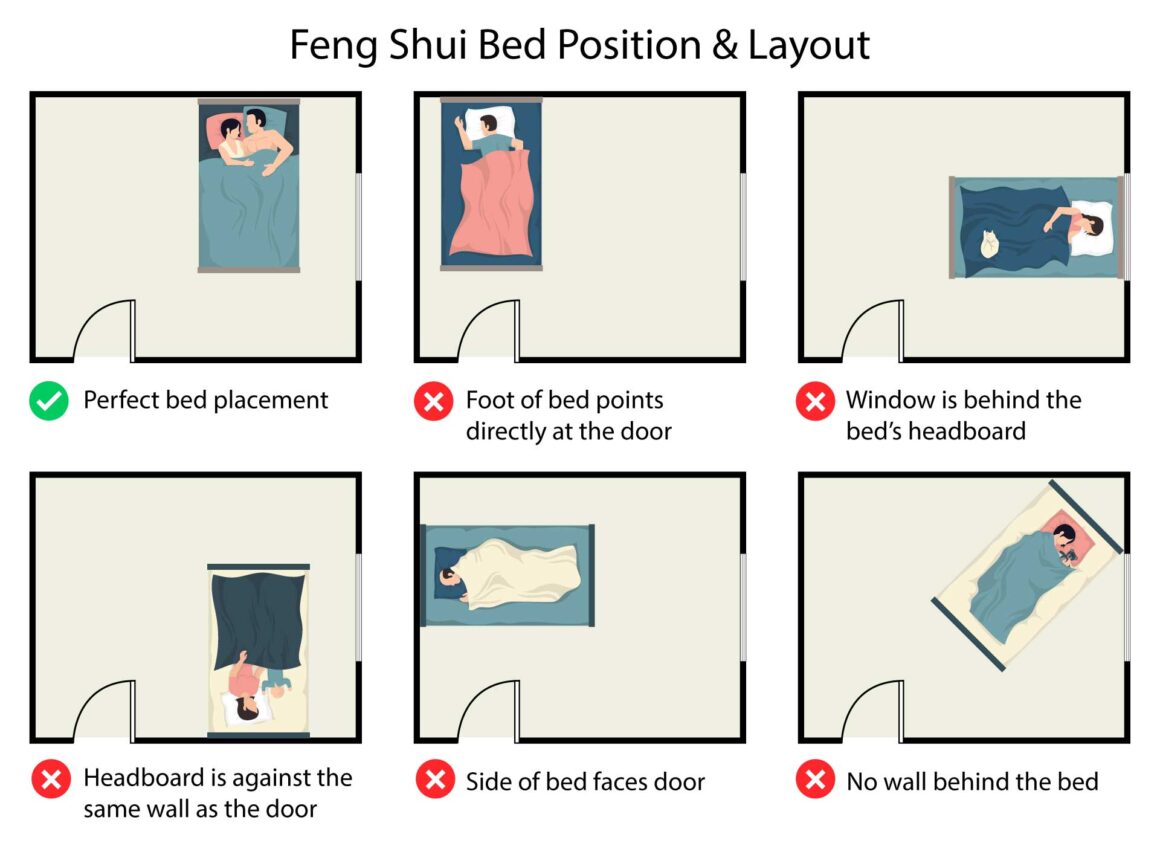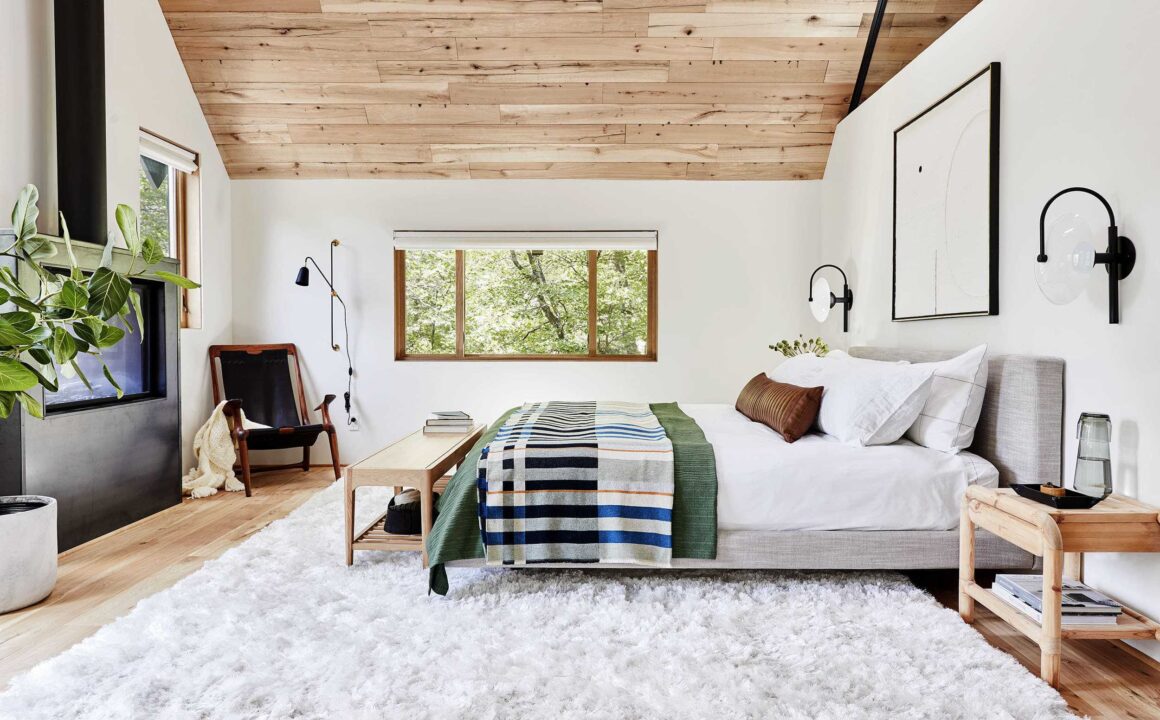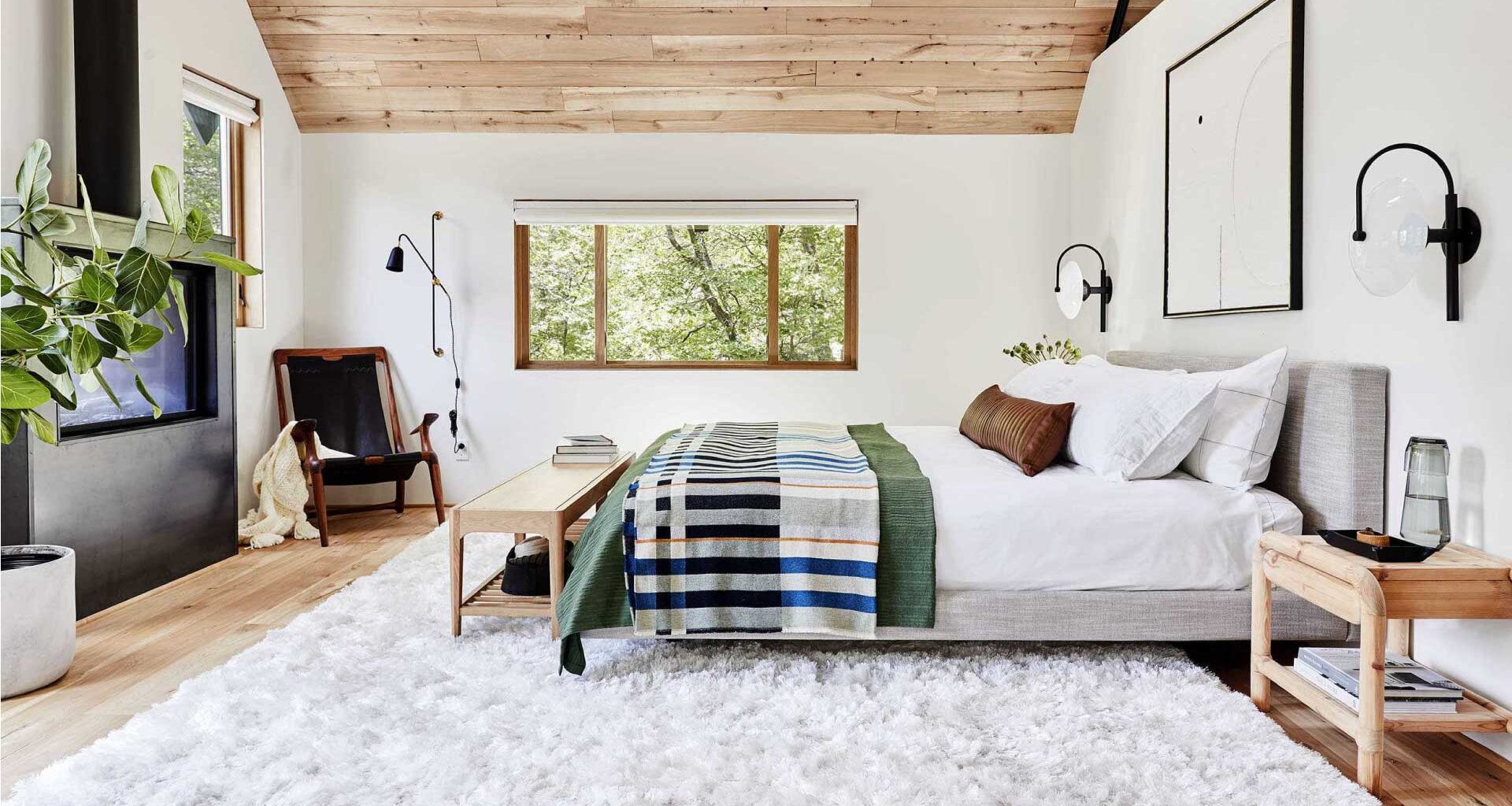In our feng shui bedroom design guide, you’ll get decorating ideas to layout your bedroom based on feng shui rules. So what exactly is feng shui? Originating from traditional Chinese astronomy and Daoism, feng shui is the practice of arranging a space so that the furniture, decor, and the surrounding environment are in harmony. The goal is to manage a space’s positive and negative qi, which means energy in Chinese. This is done by implementing a set of rules regarding positioning, spacing, and colors for everything in a physical area.
According to feng shui, the bedroom is one of the most important rooms in a home. We spend a large portion of our lives there – resting and recharging after a long day. We are also more vulnerable to spirits and negative energy when sleeping. It is therefore imperative to position our bed and decorate our room properly to protect ourselves. Here are a few guidelines and tips to promote restful sleep and intimacy, while supporting overall wellbeing and balance:
Ensure bed is in the command position

The most fundamental rule for laying out a bedroom is to place your bed in the command position. You may be wondering: what is the command position in feng shui? The command position refers to a particular placement of your bed relative to the bedroom door. When in the command position, your bed should offer you a “commanding” view of the entire room and the door. Most importantly, do not position the bed in front of the door’s direct line of sight. Instead, place the bed at an offset from the door’s forward direction, ideally diagonally to the left or right.
If done correctly, your bed should not be visible to someone staring at your bedroom from down the hall. On the other hand, you should clearly see the bedroom entrance when sitting on the bed. Moreover, you should not have any blind spots when viewing the door from your bed. Regardless of your interior design style, the command position should be referenced when placing your bed in your bedroom.
As noted by feng-shui architect Cliff Tan, “avoid placing yourself in a vulnerable position. Ensure that you have a good view of the room, are supported on your back by a wall, and that nobody is able to scare you from behind if they wish to. This is known as the command position.”
Avoid squeezing your bed against a corner

You should avoid tucking your bed against the corner of the room. Squeezing your bed against a corner can block off the qi flow on one side. Feng shui attempts to promote balance in all things, so placing you bed on a corner creates asymmetry.
Leave enough space on both sides of your bed so that you can get on/off from either side. There should only be one wall touching your bed frame – the wall for your headboard. With the freed up space, you can place a pair of matching nightstands on each side of your bed.
Balance the five elements and their colors

The five elements (metal, wood, water, fire, and earth) of feng shui imbue your room with certain attributes and benefits. For the bedroom, balancing all of these elements is important in creating a harmonious place for rest and sleep. Let’s go over each of feng shui’s five elements and what they suggest about the colors you should use in your bedroom.
The metal element in feng shui is represented by the color white, and symbolizes productivity, logic, and justice. The wood element is represented by the color blue and green, symbolizing life, growth, and rejuvenation. The water element in feng shui is represented by the color black and dark blue, symbolizing prosperity, abundance, and wisdom. The fire element is represented by the color red and symbolizes passion, alertness, and active energy. The earth element is represented by the color yellow, orange, and brown, and symbolizes stability, thoughtfulness, and royalty.
You don’t need to add each element’s color equally – in fact, that’s not recommended at all. For example, use the fire element sparingly within the bedroom as it can add too much active energy to a room meant for relaxation. There are also colors that make your room look bigger.
Don’t position bed underneath a window

According to classical feng shui guidelines, beds should lean against a solid wall and not underneath any windows. This is due to the belief that windows are a vulnerable opening where intruders can observe you from behind. If you must place your bed underneath a window due to space constraints, ensure at least that the window sills are above the top of your headboard. Also, avoid positioning your bed directly opposite a window such that your foot points at it. It is best to place your bed where you have a view of the window when seated.
Don’t point your bed towards the bathroom door
Part of the command position concept, the foot of the bed should not directly face the bathroom door.
Most people who are familiar with feng shui and the command position will know that their bed should not be directly opposite their main bedroom door. However, they may not know that this rule applies to every door in your bedroom. For master bedrooms with a bathoom, ensure that the bed is in a command position relative to the bathroom door.
Additionally, you really don’t want the bathroom door to point at your head while sleeping. According to feng shui, the bathroom can send unwanted energy towards your head/body if they’re in the direct line-of-sight of the bathroom door.

Hang art on the wall facing your door
To better guide visitors into your bedroom, you can hang artwork on the wall that directly faces the door. The wall art can redirect the gaze of visitors away from the bed, which is considered private and intimate.
An alternative to wall art is placing a console table on the wall straight ahead from the door. You can then add decorations on top of the console table to make it look prettier.
A good tip is to pick artwork and decor that can visually “trick” a person’s gaze towards a certain direction. Consider a bedroom where your bed is to the left and the desk is to the right from the door. You can choose a wall art featuring an ocean wave crashing towards the right. This will help guide visitors to look and walk towards the desk area instead of your bed.

Place your desk diagonally facing the door

Work-from-home has increased the need for home office setups. If you live in a small apartment, you’ll likely have to fit a work desk in your bedroom. Place the desk in the command position, meaning away from the door’s direct line of sight.
You should also avoid having the bedroom’s desk face the wall – that way, you can have a sweeping view of the room when seated. No matter what, never position the desk so that you face the wall directly in front of you when seated, especially if the door is behind you. Doing so will place you in an exposed and vulnerable position. Instead, try to float your desk with the desk facing the entire room with a wall behind your seat. Both the window and the door should be either to the left or right of your forward vision. That way, you can benefit from the positive and active energy flowing from the inside and outside environment.
Use room divider to section off the bedroom

Using a room divider panel or screen can help you divide your bedroom into distinct sections. It can also control the flow of energy and direct the natural pathway in your room. You can use a room divider to place your bed closer to the door, which is normally not recommended.
Additionally, you direct anyone entering your bedroom to first turn a corner and see another section of your room (preferably the work space or lounge area) before they view your bed. You can even place a room divider between your bed and the desk to separate work and rest. If you do this, make sure that the room divider isn’t so large that it obstructs the entrance. You still want to see it so that you have a commanding view when seated.
Place furniture and decor pieces in pairs

In line with feng shui’s desire for symmetry and balance, you should use bedroom furniture and decorative pieces in pairs. For example, you should have matching nightstands for your bed and a pair of lamps on your dresser.
Pairs are considered auspicious in feng shui. Having two copies of smaller furniture and decor pieces promotes harmony both in the room and in relationships. Of course, it is impractical to have some pieces such as the bed frame, dresser, and desk in pairs. This is completely okay. Just 1 or 2 pairs of furniture or decor is enough to make the point.
Maintain open space and flow

In order to promote positive qi flow throughout the room, feng shui bedrooms should have an open layout. By maintaining open corridors, you not only ensure a tidier aesthetic, but you also have more freedom to roam about.
The idea of an open layout goes in tandem with the concept of command position, which aims to guarantee that you have a clear and open view of the entire bedroom. In small bedrooms, you may have to omit furniture pieces to maintain unobstructed walkways.
In addition to freeing up space on the ground, we should also try to open up the space vertically. Try to get furniture that is lower in height so that there is less visual clutter up top.
Consider sunlight direction and indoor lighting when choosing colors

In addition to adding colors based on the five elements, try to consider the sunlight direction and the amount/color of your artificial lighting when selecting colors. Sunlight has the ability to alter the brightness of any color, and artificial lighting can even change certain colors.
For example, yellows will appear warmer in rooms that receive substantial sunlight, in which case you may want to tone down the amount of earth element you have in your bedroom. Similarly, certain blues may appear gray under artificial lighting, so you may have to adjust your wood element pieces. Learn how to brighten a dark room the right way so that your colors are consistent with what you want.
Use mirrors, but not opposite the bed

Mirrors are a great addition to a bedroom, and can add positive and active energy to the room. They create the illusion of adding more open space and reflect your every movement. Most feng shui designers caution against using mirrors in the bedroom to avoid having too much active energy. However, this is not a hard rule – you just have to be careful and thoughtful about it.
Place the mirror where you cannot see yourself through the reflection when sleeping. For example, don’t place a mirror directly opposite the foot of your bed. Instead, place the mirror on a wall that is perpendicular or diagonally from your bed’s footboard.
According to feng shui, mirrors can reflect whatever energy it sees, which can leave you vulnerable and exposed. To mitigate this, place a beautiful fabric or cloth over any large floor mirror before you go to sleep.
Minimize clutter

To allow positive energy to flow around your room, make sure to organize and declutter your bedroom at every opportunity. Minimizing clutter can lead to better hygiene and improved sleep quality, in addition to an easier time finding things. According to feng shui, decluttering helps open up your space to allow positive qi to flow freely around your room.
Avoid excessive decoration or too many patterns — minimalism is key to create an overall sense of balance. Too much clutter can create a sense of chaos or overstimulation. Focus on soft, soothing colors and textures to create a tranquil atmosphere, perfect for rest. Keeping a minimalist bedroom is easier if the room has a mid-century modern decor, but even rooms with busier styles can at least stay organized.
Balance yin and yang

A feng shui bedroom should balance opposing forces by including both yin and yang attributes. According to Daoist beliefs, the universe is formed of contrasting yet interconnected forces called yin and yang. Yin represents the dark side, and is associated with feminine, passive, cold, wet, and lunar characteristics. Yang represents the light side, and is often associated with masculine, active, warm, dry, and solar characteristics. Neither is better or worse than the other, though you may want to tip the balance more in favor of one over the other a bit based on your desired bedroom appeal and function.
In terms of feng shui bedroom decorating, balancing yin and yang means to include both soft and hard elements. For example, if you have a solid wood headboard for your bed, then pile on a few extra throw pillows or hang a woven tapestry on the wall behind it. Additionally, if your bedroom has hardwood floors, then layer an oversized rug over the floor.
In terms of yin and yang’s requirements for cold/warm and color balance, you will inevitably incorporate them if you follow our prior recommendations regarding the five elements and their colors. Each of the elements and their colors actually represent yin or yang qualities.
Use a bed with a headboard

A major part of feng shui and the command position is the idea that you should feel extra secure from behind. That’s why the recommendation is to not have any windows or doors situated behind you while sleeping on the bed. Having a headboard provides extra security behind you.
A headboard prevents your bed frame from slipping forward over time, which can happen if you enjoy sitting on your bed with your back leaned against the wall without a headboard. It also prevents any pillows from slipping under the gap between your mattress and the wall.
Limit the amount of decorative plants

Be very deliberate about the amount of plants and succulents you include in your bedroom. They represent active energy and introduce a lot of yang in your room. This could be desirable to balance out your room if it includes too many yin characteristics (either in terms of color, furniture material, etc.), but generally you don’t want to overdo it. Make sure that both the color, placement, size, and type of plants you add to your room fits into the visual balance you desire when resting on your bed.
Don’t hang a clock in a feng shui bedroom
If at all possible, try to avoid hanging a block in your bedroom. This applies to both traditional pendulum clocks as well as digital clocks. If you do choose to have a clock in your bedroom, opt for a bedside clock that you can place on a nightstand and not a hung wall clock. A major no-no is hanging a clock over your bed’s headboard. Clocks represent the relentless passage of time in feng shui, punctuality/productivity, and reminder of the end times.

Keep bookshelves out of the bedroom

According to feng shui, the bedroom’s main focus is for sleeping and building a better bond with your partner. Though western bedrooms typically love placing books around the house including the bedroom, feng shui typically advises the bedroom to be clear of books as much as possible. If you must, keep the bookshelf to a small one with just your favorites.
Of course, a bedside read is completely fine, but you should avoid having an entire bookshelf (small or large). Books are for knowledge and should be placed in the wisdom corner of your house such as your home office. According to feng shui bagua maps, which dictates which rooms should focus on which functions/benefits, the office is part of the wisdom corner of you home but not your bedroom.
Use curtains to control energy from windows
Depending on what you see and hear from your windows, your bedroom will receive different amounts of energy from the outside environment. For example, if your bedroom is on the ground floor and there are cars or traffic outside, there will be a lot of unwanted energy coming through those windows.
Use curtains to fine-tune the amount of energy into your room, both good and bad. A thinner see-through curtain is a great option if you have a beautiful, peaceful view, while a thicker blackout curtain might be better if your faced with a busy and loud urban environment.

Prioritize the important feng shui rules
Given all the different feng shui decorating ideas, you may feel overwhelmed with all the rules. That’s perfectly normal! Depending on your bedroom’s layout and size, some of the rules have to be broken in order to fit the bed and whatever other furniture pieces you have. Fortunately, not all feng shui rules are equally important, so you can follow the below ranking of priorities to focus on implementing the most important ones.
The most important feng shui bedroom decorating rules pertain to the placement of the bed in the command position. Specifically, don’t place your bed so that its foot directly points toward any door. Secondly, don’t place your bed so that your head is in close proximity to the door. Third, make sure your bed leans against exactly one wall, which should be the one for your bed’s headboard. You’re free to bend the other rules based on different circumstances.







